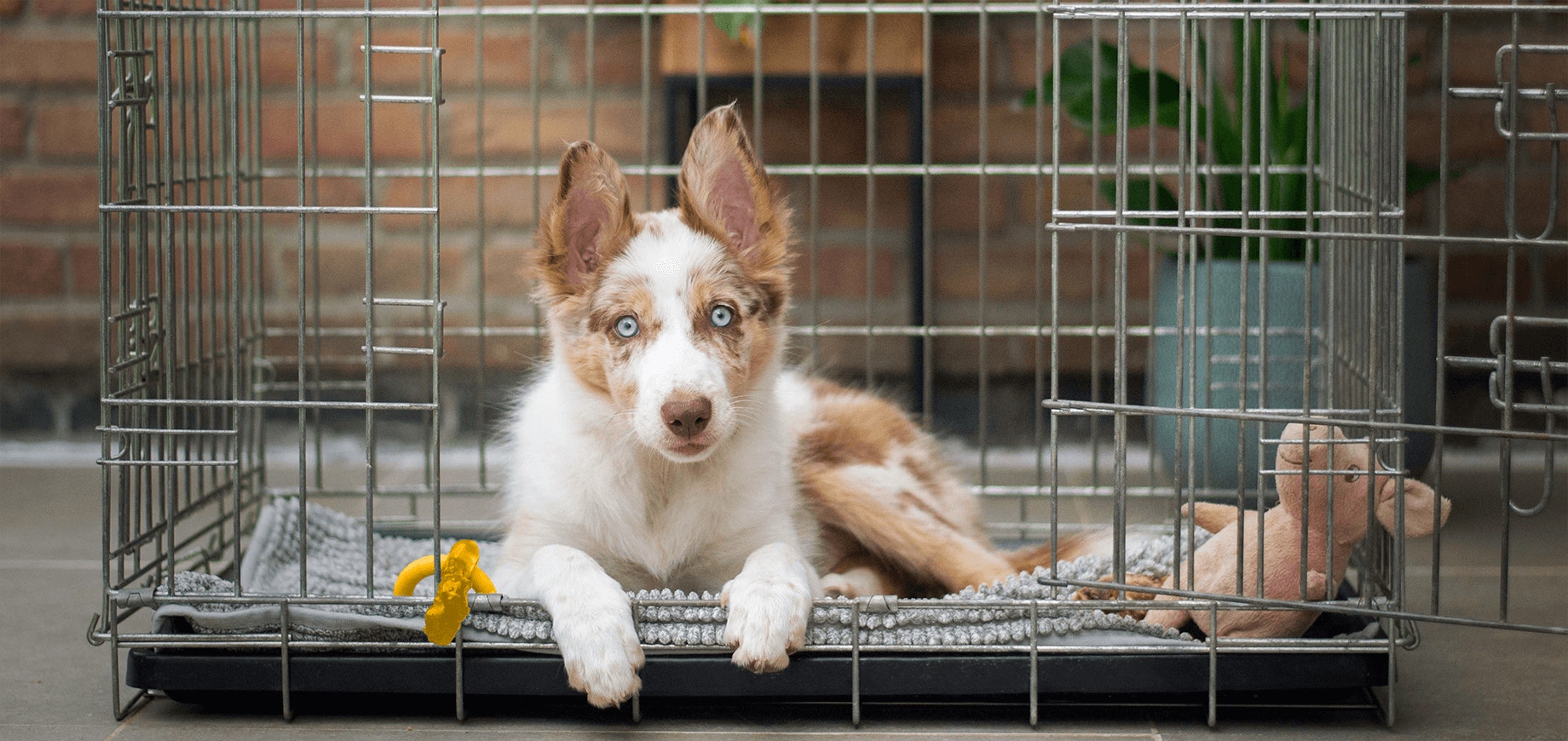Some people don’t like the idea of crate training a puppy but it’s worth bearing in mind that lots of dogs enjoy small, cosy spaces which can help them to feel secure. In fact, if a dog has got used to going in a crate from a young age, it can even help them feel calmer if they’re a bit anxious. Perhaps the best way to think of a crate is your puppy’s own personal ‘den’.
Why crate train a puppy?
There are lots of reasons why crate training is a good idea:
- A crate gives your puppy somewhere to go if they’re tired or they want to ‘escape’ for a bit
- A crate is a great place for your puppy to sleep at night
- A crate is a safe place for your puppy when you’re unable to supervise them
- A crate can make toilet training easier as dogs naturally try to avoid making a mess where they sleep
- A crate is useful when you need to keep your puppy safe and away from hazards such as a busy kitchen
- A crate can help your puppy settle into new environments. It’s their little ‘home from home’
- A crate that’s suitable for travel can make travelling with a dog easier
- A crate can help contain your pet post-vet visit to help them heal faster
How to choose the best crate for your puppy
Broadly speaking, there are three main types of crates to choose from – metal, plastic and fabric. What you choose depends on your puppy’s preferences and the primary purpose of the crate. If you often travel in the car with your puppy, for example, you’ll probably want something quite lightweight but safe.
It’s important to get a crate that’s the perfect size. It needs to be large enough for your dog to stand up in, turn around and lie down comfortably. Don’t forget you’ve got to think about how big your puppy is going to be when they’re fully grown. If the crate seems too huge for your tiny pup, you could look at buying a crate that has dividers that can be removed, allowing the crate size to increase in line with your growing puppy. Another option is to see if your local animal shelter has crates for hire.
How to crate train your puppy in 5 easy steps
Crate training a puppy needn’t be difficult, but you will need to be a little patient because it could take a few weeks before your puppy is fully used to their crate. With patience and consistency there’s no reason why your furry friend won’t come to love their ‘den’.
- Step 1: Get ready
Before you get your puppy near the crate, you’ll want to make sure it’s cosy and comfortable for them. Place it in a quiet, calm area away from direct heat or draughts. Add some comfy bedding, a non-spill water bowl and some of your puppy’s favourite toys.
- Step 2: Let your puppy explore the crate
Once you’ve got the crate puptastically cosy, it’s time to let your furry friend explore it. The important thing here is to let your puppy do this on their own terms. You want to make sure the door is open and should never force your puppy into the crate. It’s fine to gently encourage exploration and treats can come in handy here. The PEDIGREE™ Tasty Mini puppy range is perfect for placing in your puppy’s crate. These treats are low in fat and contain Omega 3, Vitamin E and calcium.
- Step 3: Build up the time your puppy is in the crate
Once your puppy is starting to get accustomed to their crate, you will want to start slowly building up the amount of time they’re in there. A good way of doing this is to feed them in their crate. (On which subject, don’t miss our tips on feeding your puppy.) It’s still important you make sure the door stays open though. That step is coming next …
- Step 4: Closing the crate door
Once you think that your puppy is getting used to being in their crate, you can start shutting the door. It’s important you take this very gradually, only shutting the door for the briefest amount of time at first and opening it again if your puppy shows any signs of wanting to get out.
- Step 5: Leaving your puppy in the crate
When your puppy is seeing their crate as a nice cosy space they’re happy in, you can progress to leaving them in there unsupervised. Don’t do this for too long though. Apart from anything else, a small puppy doesn’t have the bladder or bowel control to be in their crate for ages.
The dos and don’ts of crate training
Now we’ve broken down how to crate train a puppy into manageable steps, let’s recap a few dos and don’ts:
- Do be patient and consistent
- Do make your puppy’s crate inviting
- Do observe your puppy’s body language and if they are displaying signs of fear or stress go back to an earlier step in training
- Do make sure your puppy goes to the toilet just before going into their crate
- Don’t leave your puppy in their crate for too long
- Don’t try to do too much too soon
- Don’t use the crate as a punishment
Putting your puppy in the crate at night
If you’ve been sleep training your puppy, you might have thought about using your puppy’s crate at night in which case, you’re bound to have questions!
Is it okay to crate a puppy at night?
It’s fine to crate a puppy at night. Their crate is a safe and cosy place for them to sleep.
Should I put my eight week old puppy in a crate at night?
There’s no reason why you shouldn’t put an eight-week-old puppy in their crate at night. If you have only just brought them home, it can be a good idea to place a blanket that smells of their mum and their littermates inside the crate.
Should you close the door on a puppy crate at night?
It’s fine to close the door on your puppy’s crate at night. This keeps them safe and often reduces any howling or whining. Your puppy will probably feel happier if you place the crate where they can see you.
How long does it take to crate train a puppy?
All puppies are individuals which means it’s impossible to say exactly how long it will take to crate train them. That said, if you’re patient and consistent, you can expect your furry friend to be a crate pro before too long.
Crate training your puppy can be useful for all sorts of other training. Read more about how to use a crate for toilet training your puppy.


